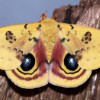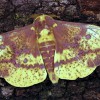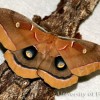 The beautiful Io moth is one of our most recognizable moths, because of its prominent hind wing eyespots. The attractive Io moth caterpillar is also well-known because of its painful sting. But like many of the other saturniid moths, is less common now in parts of its range. With the exception of Cape Cod and some of the Massachusetts islands, it is now rare in New England where it was once common, and its populations have declined in most of the Gulf States since the 1970s. This 12-page fact sheet was written by Donald W. Hall, and published by the UF Department of Entomology and Nematology, December 2014. (Photo: Donald W. Hall, UF/IFAS)
The beautiful Io moth is one of our most recognizable moths, because of its prominent hind wing eyespots. The attractive Io moth caterpillar is also well-known because of its painful sting. But like many of the other saturniid moths, is less common now in parts of its range. With the exception of Cape Cod and some of the Massachusetts islands, it is now rare in New England where it was once common, and its populations have declined in most of the Gulf States since the 1970s. This 12-page fact sheet was written by Donald W. Hall, and published by the UF Department of Entomology and Nematology, December 2014. (Photo: Donald W. Hall, UF/IFAS)
http://edis.ifas.ufl.edu/in1065
Tag: Family: Saturniidae
Imperial Moth Eacles imperialis imperialis (Drury, 1773) (Insecta: Lepidoptera: Saturniidae: Ceratocampinae)
 The imperial moth is one of our largest and most beautiful moths. It is also the most variable in appearance and the most widely distributed of our large eastern U.S. saturniid moths. This 9-page fact sheet was written by Donald W. Hall, and published by the UF Department of Entomology and Nematology, September 2014.
The imperial moth is one of our largest and most beautiful moths. It is also the most variable in appearance and the most widely distributed of our large eastern U.S. saturniid moths. This 9-page fact sheet was written by Donald W. Hall, and published by the UF Department of Entomology and Nematology, September 2014.
(Photo: Donald W. Hall, University of Florida) http://edis.ifas.ufl.edu/in1051
Polyphemus Moth Antheraea polyphemus (Cramer) (Insecta: Lepidoptera: Saturniidae: Saturniinae) (EENY531/IN945)
 The polyphemus moth, Antheraea polyphemus (Cramer), is one of our largest and most beautiful silk moths. It is named after Polyphemus, the giant cyclops from Greek mythology who had a single large, round eye in the middle of his forehead. The name is because of the large eyespots in the middle of the moth’s hind wings. This 9-page fact sheet was written by Donald W. Hall, and published by the UF Department of Entomology and Nematology, August 2012.
The polyphemus moth, Antheraea polyphemus (Cramer), is one of our largest and most beautiful silk moths. It is named after Polyphemus, the giant cyclops from Greek mythology who had a single large, round eye in the middle of his forehead. The name is because of the large eyespots in the middle of the moth’s hind wings. This 9-page fact sheet was written by Donald W. Hall, and published by the UF Department of Entomology and Nematology, August 2012.
http://edis.ifas.ufl.edu/in945
EENY478/IN861 Cecropia Moth, Cecropia Silk Moth, Robin Moth, Hyalophora cecropia Linnaeus (Insecta: Lepidoptera: Saturniidae: Saturniinae: Attacini)
EENY478, a 5-page illustrated fact sheet by Geoffrey R. Gallice, is part of the Featured Creatures collection. It describes this spectacular member of the Saturniidae family — synonymy, distribution, hosts, and economic importance. Includes references. Published by the UF Department of Entomology and Nematology, July 2010.
http://edis.ifas.ufl.edu/in861
EENY464/IN834 Buck moth Hemileuca maia (Drury)
EENY464, a 6-page illustrated fact sheet by Clare Scott and Phillip E. Kaufman, is part of the Featured Creatures Collection. It describes this moth in the giant silkworm family, the larvae of which has stinging spines — synonymy, distribution, description, life cycle, hosts, and medical importance. Includes references. Published by the UF Department of Entomology and Nematology, November 2009.
http://edis.ifas.ufl.edu/IN834